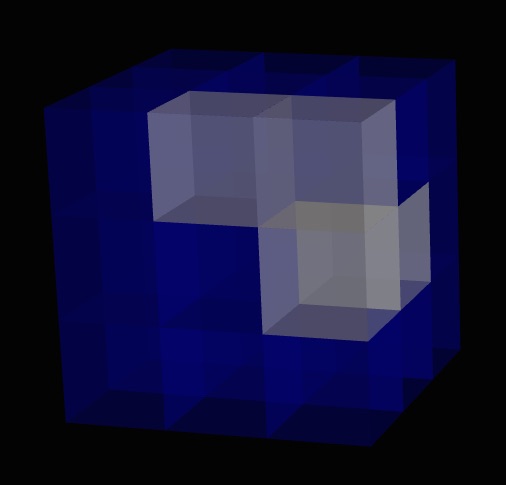If you look at the puzzle piece I showed yesterday within the Soma cube (the Soma cube was invented by Piet Hein in 1936), you can see that it takes up 4 out of the 27 positions in the assembled 3x3x3 cube:

I am showing each of the component cubes as transparent blue, except for those inside the puzzle piece, which I am showing as transparent white. You can see that the puzzle piece traces a path first right, then back, then down.
Showing the parts of a 4D hypercube puzzle is a little trickier. I don’t just want to show an exploded view, because I’d like the player to be able to see the puzzle as though it were a physical object, and rotate it interactively.
So in addition to left/right, down/up, and back/forward, I am adding the additional dimension of in/out. You can think of it as a kind of extra perspective dimension, as though things look smaller as they retreat away from us into this fourth dimension.
Looked at this way, here is a puzzle piece within the 4D hypercube puzzle. You can see that it takes up 5 out of the 16 positions in the assembled 4x4x4x4 hypercube:

Again, I am showing each of the component hypercubes as transparent blue, except for those inside the puzzle piece, which I am showing as transparent white. You can see that the puzzle piece traces a path first out, then right, then back, then down.
In “Stranger in a Strange Land,” there’s a scene where Valentine Smith makes an object disappear via a fourth spacial dimension and several 3D cameras recording the scene all perceive the object as moving “away” from them, regardless of which angle they recorded the scene from. (Apologies if I mangled the recollection, this was a couple decades ago that I read it)
Anyway, I’m wondering if this is something that could translate to VR – make the interocular depth cues represent depth in the *fourth* dimension rather than the third. The camera for each eye would be located at the same point in the normal three dimensions so that any object that’s “flat” in the fourth dimension would be drawn without any interocular depth cues, only the normal perspective cues that are present in normal 2D images of 3D objects. However, the cameras are spaced out in the fourth dimension so that interocular depth cues are created wherever an object has thickness in the fourth dimension.
At the very least this would be a trippy effect, but if it could lead to a more intuitive way to represent and visualize the fourth dimension it could be a huge win.
Good observation. Yes, that is exactly what we have been doing to interact with 4D objects in VR at our lab. The results are especially satisfying then you rotate the 4D objects within the full four dimensional space.
We find that we get the best results when interocular disparity is keyed to both of the two coordinates that are currently perpendicular to the user’s view. If we label those two axes as z and w, then we just define “distance” as sqrt(z*z + w*w).
It’s an approach that has been in use for decades. What is different now is that high quality VR is now affordable, thanks to the VIVE and similar products.
By the way, a caution about rereading Stranger in a Strange Land: For me, it turned out to be a great disappointment, because as an adult I couldn’t ignore Heinlein’s disturbingly retro sexual politics.